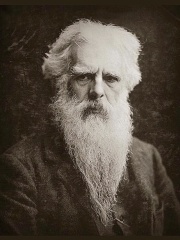
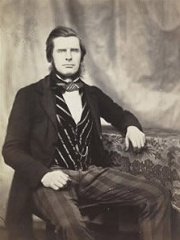
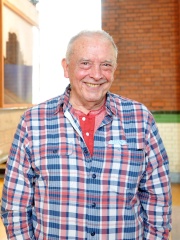
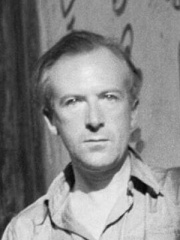
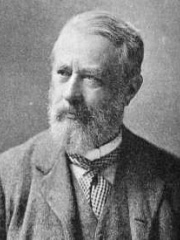
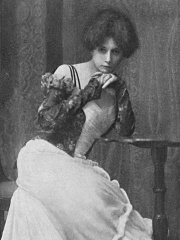
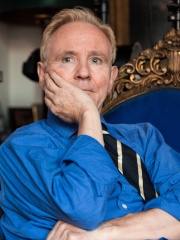

The Most Famous
PHOTOGRAPHERS from United Kingdom
This page contains a list of the greatest British Photographers. The pantheon dataset contains 148 Photographers, 9 of which were born in United Kingdom. This makes United Kingdom the birth place of the 4th most number of Photographers behind France, and Germany.
Top 9
The following people are considered by Pantheon to be the most legendary British Photographers of all time. This list of famous British Photographers is sorted by HPI (Historical Popularity Index), a metric that aggregates information on a biography's online popularity.

1. Eadweard Muybridge (1830 - 1904)
With an HPI of 71.33, Eadweard Muybridge is the most famous British Photographer. His biography has been translated into 51 different languages on wikipedia.
Eadweard Muybridge ( ED-wərd MY-brij; 9 April 1830 – 8 May 1904, born Edward James Muggeridge) was an English photographer known for his pioneering work in photographic studies of motion, and early work in motion-picture projection. He adopted the first name "Eadweard" as the original Anglo-Saxon form of "Edward", and the surname "Muybridge", believing it to be similarly archaic. A photographer in the 19th century American West, he photographed Yosemite, San Francisco, the newly acquired Alaskan Territory, subjects involved in the Modoc War, and lighthouses on the West Coast. He also made his early moving picture studies in California. Born in Kingston upon Thames, Surrey, England, at the age of 20 he emigrated to the United States as a bookseller, first to New York City, then to San Francisco. In 1860, he planned a return trip to Europe, but suffered serious head injuries en route in a stagecoach crash in Texas. He spent the next few years recuperating in Kingston upon Thames, where he took up professional photography, learned the wet-plate collodion process, and secured at least two British patents for his inventions. He returned to San Francisco in 1867, a man with a markedly changed personality. In 1868, he exhibited large photographs of Yosemite Valley, and began selling popular stereographs of his work. Muybridge is known for his pioneering chronophotography of animal locomotion between 1878 and 1886, which used multiple cameras to capture the different positions in a stride; and for his zoopraxiscope, a device for projecting painted motion pictures from glass discs that predated the flexible perforated film strip used in cinematography. From 1883 to 1886, he entered a very productive period at the University of Pennsylvania in Philadelphia, producing over 100,000 images of animals and humans in motion, occasionally capturing what the human eye could not distinguish as separate moments in time. In his later years, Muybridge gave many public lectures and demonstrations of his photography and early motion picture sequences, travelling frequently in England and Europe to publicise his work in cities such as London and Paris. He also edited and published compilations of his work (some of which are still in print today), which greatly influenced visual artists and the developing fields of scientific and industrial photography. He retired to his native England permanently in 1894. In 1904, the year of his death, the Kingston Museum opened in his hometown, and continues to house a substantial collection of his works in a dedicated gallery.

2. Roger Fenton (1819 - 1869)
With an HPI of 63.26, Roger Fenton is the 2nd most famous British Photographer. His biography has been translated into 29 different languages.
Roger Fenton (28 March 1819 – 8 August 1869) was a British photographer, noted as one of the first war photographers. Fenton was born into a Lancashire merchant family. After graduating from London with an arts degree, he became interested in painting. After seeing examples of the new technology of photography at the Great Exhibition in 1851, he became keenly interested in this new technique. Within a year, he began exhibiting his own photographs. He became a leading British photographer and was instrumental in founding the Photographic Society (later the Royal Photographic Society). In 1854, he was commissioned to document events occurring in Crimea, where he became one of a small group of photographers to produce images of the final stages of the Crimean War.

3. David Bailey (b. 1938)
With an HPI of 62.61, David Bailey is the 3rd most famous British Photographer. His biography has been translated into 17 different languages.
David Royston Bailey (born 2 January 1938) is an English photographer and director, most known for his fashion photography and portraiture, and role in shaping the image of the Swinging Sixties. Bailey has also directed several television commercials and documentaries.

4. Cecil Beaton (1904 - 1980)
With an HPI of 60.80, Cecil Beaton is the 4th most famous British Photographer. His biography has been translated into 29 different languages.
Sir Cecil Walter Hardy Beaton (14 January 1904 – 18 January 1980) was a British fashion, portrait and war photographer, diarist, painter, and interior designer, as well as costume designer and set designer for stage and screen. His accolades include three Academy Awards and four Tony Awards.
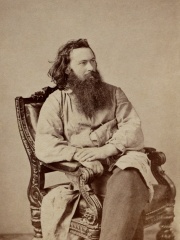
5. Alexander Gardner (1821 - 1882)
With an HPI of 59.59, Alexander Gardner is the 5th most famous British Photographer. His biography has been translated into 15 different languages.
Alexander Gardner (October 17, 1821 – December 10, 1882) was a Scottish-American photographer who immigrated to the United States in 1856, where he began to work full-time in that profession. He is best known for his photographs of the American Civil War, U.S. President Abraham Lincoln, and of the conspirators and the execution of the participants in the Lincoln assassination plot.

6. Henry Peach Robinson (1830 - 1901)
With an HPI of 56.76, Henry Peach Robinson is the 6th most famous British Photographer. His biography has been translated into 15 different languages.
Henry Peach Robinson (9 July 1830, Ludlow, Shropshire – 21 February 1901, Royal Tunbridge Wells, Kent) was an English pictorialist photographer best known for his pioneering combination printing, an early example of photomontage. He engaged in contemporary debates in the photographic press and associations about the legitimacy of 'art photography' and in particular the combining of separate images into one.

7. Zaida Ben-Yusuf (1869 - 1933)
With an HPI of 54.68, Zaida Ben-Yusuf is the 7th most famous British Photographer. Her biography has been translated into 16 different languages.
Zaida Ben-Yusuf (November 21, 1869 – September 27, 1933) was an American portrait photographer based in New York. She was known for her artistic portraits of wealthy, fashionable, and famous Americans during the turn of the 19th–20th century. In 1901, The Ladies Home Journal featured her and six other photographers as "The Foremost Women Photographers in America". In 2008, the Smithsonian National Portrait Gallery mounted an exhibition dedicated solely to Ben-Yusuf's work, re-establishing her as a key figure in the early development of fine art photography.

8. Allan Warren (b. 1948)
With an HPI of 53.21, Allan Warren is the 8th most famous British Photographer. His biography has been translated into 22 different languages.
Michael Allan Warren (born 26 October 1948) is an English portrait photographer and actor, primarily known for his portraits of British nobility, politicians, and celebrities. His subjects include Charles III, Constantine II, Cary Grant, Enoch Powell, Alec Douglas-Home, Sophia Loren, Louis Mountbatten and Laurence Olivier.

9. Mick Rock (1948 - 2021)
With an HPI of 50.68, Mick Rock is the 9th most famous British Photographer. His biography has been translated into 16 different languages.
Michael David Rock (born Michael Edward Chester Smith; 21 November 1948 – 18 November 2021) was a British photographer. He photographed rock music acts such as Queen, David Bowie, Waylon Jennings, T. Rex, Syd Barrett, Lou Reed, Iggy Pop and The Stooges, The Sex Pistols, Ozzy Osbourne, The Ramones, Joan Jett, Talking Heads, Roxy Music, Thin Lizzy, Geordie, Mötley Crüe, Blondie and Third Eye Blind. Often referred to as "The Man Who Shot the Seventies", he shot most of the memorable photos of Bowie as Ziggy Stardust in his capacity as Bowie's official photographer. Rock's work is held in the collection of the National Portrait Gallery, London.
People
Pantheon has 9 people classified as British photographers born between 1819 and 1948. Of these 9, 2 (22.22%) of them are still alive today. The most famous living British photographers include David Bailey, and Allan Warren. The most famous deceased British photographers include Eadweard Muybridge, Roger Fenton, and Cecil Beaton.
Living British Photographers
Go to all RankingsDeceased British Photographers
Go to all RankingsEadweard Muybridge
1830 - 1904
HPI: 71.33
Roger Fenton
1819 - 1869
HPI: 63.26
Cecil Beaton
1904 - 1980
HPI: 60.80
Alexander Gardner
1821 - 1882
HPI: 59.59
Henry Peach Robinson
1830 - 1901
HPI: 56.76
Zaida Ben-Yusuf
1869 - 1933
HPI: 54.68
Mick Rock
1948 - 2021
HPI: 50.68
Overlapping Lives
Which Photographers were alive at the same time? This visualization shows the lifespans of the 7 most globally memorable Photographers since 1700.

